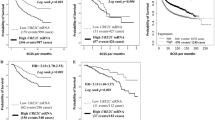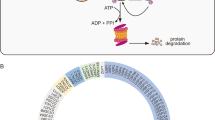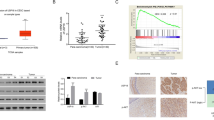Abstract
Ubiquitin-specific protease 22 (USP22) exhibits an important function in tumor progression and oncogenesis. The aim of this study was to investigate the role of USP22 and the association with its potential targets in patients with cervical cancer. To our knowledge, this is the first study that determines the relationship between USP22 expression and clinicopathological significance in cervical cancer. The immunohistochemistry results showed that USP22 protein was overexpressed in cervical cancer samples compared with normal cervical tissues (P < 0.001). Moreover, clinicopathological analysis showed that USP22 expression was highly related to International Federation of Gynecology and Obstetrics stage, Ki67, lymph node metastasis, and histology grade. The results of Kaplan–Meier analysis indicated that patients with high USP22 expression had significantly shorter overall survival (OS) and disease-free survival (DFS) than patients with low expression of USP22 (P < 0.001). Multivariate Cox regression analysis revealed that USP22 expression status was an independent prognostic marker for both OS and DFS of patients with cervical cancer. It is suggested that USP22 overexpression may be associated with poor prognosis in cervical cancer. It may represent a novel prognostic biomarker or a target for improving the treatment efficiency of patients with cervical cancer.

Similar content being viewed by others
References
Jones SB. Cancer in the developing world: a call to action. BMJ. 1999;319:505–8.
Parkin DM, Bray F, Ferlay J, et al. Global cancer statistics, 2002. CA Cancer J Clin. 2005;55:74–108.
Siegel R, Naishadham D, Jemal A. Cancer statistics. CA Cancer J Clin. 2013;63:11–30.
Siegel R, Ward E, Brawley O, Jemal A. Cancer statistics, 2011: the impact of eliminating socioeconomic and racial disparities on premature cancer deaths. CA Cancer J Clin. 2011;61:212–36.
Munoz N, Bosch FX, de Sanjose S, et al. Epidemiologic classification of human papillomavirus types associated with cervical cancer. N Engl J Med. 2003;348:518–27.
Syrjanen K, Kataja V, Yliskoski M, Chang F, Syrjanen S, Saarikoski S. Natural history of cervical human papillomavirus lesions does not substantiate the biologic relevance of the Bethesda System. Obstet Gynecol. 1992;79:675–82.
Castellsague X. Natural history and epidemiology of HPV infection and cervical cancer. Gynecol Oncol. 2008;110(3suppl2):S4–7.
Saslow D, Castle PE, Cox JT, et al. American Cancer Society Guideline for human papillomavirus (HPV) vaccine use to prevent cervical cancer and its precursors. CA Cancer J Clin. 2007;57:7–28.
Hoeller D, Dikic I. Targeting the ubiquitin system in cancer therapy. Nature. 2009;458:438–44.
Lee HJ, Kim MS, Shin JM, Park TJ, Chung HM, et al. The expression patterns of deubiquitinating enzymes, USP22 and Usp22. Gene Expr Patterns. 2006;6:277–84.
Glinsky GV. Genomic models of metastatic cancer: functional analysis of death-from-cancer signature genes reveals aneuploid, anoikis-resistant, metastasis-enabling phenotype with altered cell cycle control and activated Polycomb Group (PcG) protein chromatin silencing pathway. Cell Cycle. 2006;5:1208–16.
Zhao Y, Lang G, Ito S, et al. A TFTC/STAGA module mediates histone H2A and H2B deubiquitination, coactivates nuclear receptors, and counteracts heterochromatin silencing. Mol Cell. 2008;29:92–101.
Zhang XY, Varthi M, Sykes SM, et al. The putative cancer stem cell marker USP22 is a subunit of the human SAGA complex required for activated transcription and cell-cycle progression. Mol Cell. 2008;29:102–11.
Zhang XY, Pfeiffer HK, Thorne AW, et al. USP22, an hSAGA subunit and potential cancer stem cell marker, reverses the polycomb-catalyzed ubiquitylation of histone H2A. Cell Cycle. 2008;7:1522–4.
Bouchard C, Dittrich O, Kiermaier A, et al. Regulation of cyclin D2 gene expression by the Myc/Max/Mad network: Myc-dependent TRRAP recruitment and histone acetylation at the cyclin D2 promoter. Genes Dev. 2001;15:2042–7.
Feinberg AP, Tycko B. The history of cancer epigenetics. Nat Rev Cancer. 2004;4:143–53.
Jones PA, Baylin SB. The epigenomics of cancer. Cell. 2007;128:683–92.
Glinsky GV. “Stemness” genomics law governs clinical behavior of human cancer: implications for decision making in disease management. J Clin Oncol. 2008;26:2846–53.
Liu YL, Yang YM, Xu H, et al. Aberrant expression of USP22 is associated with liver metastasis and poor prognosis of colorectal cancer. J Surg Oncol. 2011;103:283–9.
Liu YL, Yang YM, Xu H, et al. Increased expression of ubiquitin-specific protease 22 can promote cancer progression and predict therapy failure in human colorectal cancer. J Gastroenterol Hepatol. 2010;25:1800–5.
Zhang Y, Yao L, Zhang X, et al. Elevated expression of USP22 in correlation with poor prognosis in patients with invasive breast cancer. J Cancer Res Clin Oncol. 2011;137:1245–53.
Lv L, Xiao XY, Gu ZH, et al. Silencing USP22 by asymmetric structure of interfering RNA inhibits proliferation and induces cell cycle arrest in bladder cancer cells. Mol Cell Biochem. 2011;346:11–21.
Pijnappel WW, Timmers HT. Dubbing SAGA unveils new epigenetic crosstalk. Mol Cell. 2008;29:152–4.
Atanassov BS, Dent SY. USP22 regulates cell proliferation by deubiquitinating the transcriptional regulator FBP1. EMBO Rep. 2011;12:924–30.
Chipumuro E, Henriksen MA. The ubiquitin hydrolase USP22 contributes to 3′-end processing of JAK-STAT-inducible genes. FASEB J. 2012;26:842–54.
Liu YL, Jiang SX, Yang YM, et al. USP22 acts as an oncogene by the activation of BMI-1-mediated INK4a/ARF pathway and Akt pathway. Cell Biochem Biophys. 2011;62:229–35.
Song H, Li C, Li R, Geng J. Prognostic significance of AEG-1 expression in colorectal carcinoma. Int J Colorectal Dis. 2010;25:1201–9.
Wu J, Zhou J, Yao L, Lang Y, Liang Y, Chen L, et al. High expression of M3 muscarinic acetylcholine receptor is a novel biomarker of poor prognostic in patients with non-small cell lung cancer. Tumor Biol. 2013. doi:10.1007/s13277-013-0982-x.
Li C, Li Y, Wang X, Wang Z, Cai J, et al. Elevated expression of astrocyte elevated gene-1 (AEG-1) is correlated with cisplatin-based chemoresistance and shortened outcome in patients with stages III–IV serous ovarian carcinoma. Histopathology. 2012;60:953–63.
Liang M, Li J, Wang D, Li S, Sun Y, Sun T, et al. T-cell infiltration and expressions of T lymphocyte co-inhibitory B7-H1 and B7-H4 molecules among colorectal cancer patients in northeast China’s Heilongjiang province. Tumor Biol. 2013. doi:10.1007/s13277-013-1006-6.
Li C, Cai J, Geng J, Li Y, Wang Z, Li R. Purification, characterization and anticancer activity of a polysaccharide from Panax ginseng. Int J Biol Macromol. 2012;51:968–73.
Cai J, Wu Y, Li C, Feng M, Shi Q, Li R, et al. Panax ginseng polysaccharide suppresses metastasis via modulating Twist expression in gastric cancer. Int J Biol Macromol. 2013;57:22–5.
Xin T, Zhang F, Jiang Q, Chen C, Huang D, et al. The inhibitory effect of a polysaccharide from Codonopsis pilosula on tumor growth and metastasis in vitro. Int J Biol Macromol. 2012;51:788–93.
Xin T, Zhang F, Jiang Q, Chen C, Huang D, et al. Extraction, purification and antitumor activity of a water-soluble polysaccharide from the roots of Polygala tenuifolia. Carbohydr Polym. 2012;90:1127–31.
Xin T, Zhang F, Jiang Q, Chen C, Huang D, et al. Purification and antitumor activity of two acidic polysaccharides from the roots of Polygala tenuifolia. Carbohydr Polym. 2012;90:1671–6.
Lin M, Xia B, Yang M, Gao S, Huo Y, Lou G. Characterization and antitumor activities of a polysaccharide from the rhizoma of Menispermum dauricum. Int J Biol Macromol. 2013;53:72–6.
Lin M, Xia B, Yang M, Gao S, Huo Y, Lou G. Anti-ovarian cancer potential of two acidic polysaccharides from the rhizoma of Menispermum dauricum. Carbohydr Polym. 2013;92:2212–7.
Kripke ML. Reducing death from cancer: what will it take? Tumor Biol. 2012;33:1275–8.
Zhu W, Pan X, Li F, Zhang Y, Lu X. Expression of Beclin 1 and LC3 in FIGO stage I–II cervical squamous cell carcinoma and relationship to survival. Tumor Biol. 2012;33:1653–9.
Acknowledgments
The authors thank all the people and patients who had participated in this study. This work is supported by the National Natural Science Foundation of China (No.: 81172453).
Conflicts of interest
None
Author information
Authors and Affiliations
Corresponding author
Rights and permissions
About this article
Cite this article
Yang, M., Liu, YD., Wang, YY. et al. Ubiquitin-specific protease 22: a novel molecular biomarker in cervical cancer prognosis and therapeutics. Tumor Biol. 35, 929–934 (2014). https://doi.org/10.1007/s13277-013-1121-4
Received:
Accepted:
Published:
Issue Date:
DOI: https://doi.org/10.1007/s13277-013-1121-4




